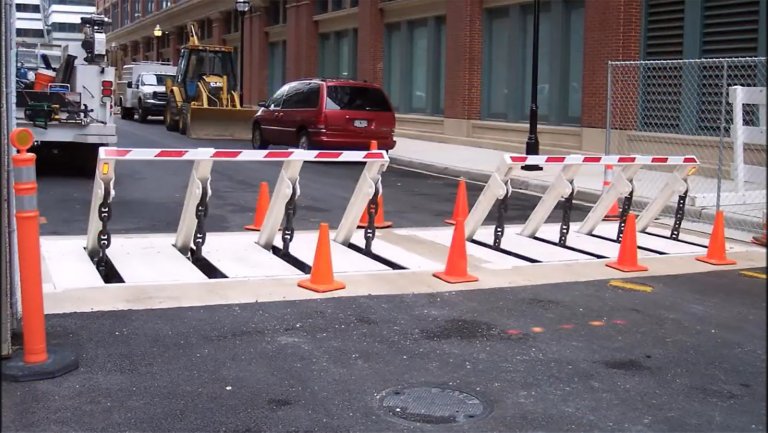The smart Trick of Wedge Barriers That Nobody is Talking About
7 Simple Techniques For Wedge Barriers
Table of ContentsEverything about Wedge BarriersWedge Barriers - The Facts


18 may be done quicker, easily, and price effectively. FIG. In certain embodiments, the support 30 might be a steel frame including plates, light beams(e. g., I-beams ), and/or various other frameworks that are protected within the structure 14, which might be concrete. At the surface 12, a top side 28 of the anchor 30 may go to the very least partly exposed
, consequently making it possible for the add-on of the barrier 10 to the anchor 30. g., threaded openings)in several light beams or plates of the support 30 might be revealed to the surface area 12. In this manner, screws 32 or other mechanical fasteners might be made use of to protect the obstacle 10 to the anchor 30. As the obstacle 10 is mounted to the surface 12 of the foundation 14, collection of particles and various other material under the barrier may be reduced, and elements of the bather 10 might not be revealed to below grade atmospheres. As shown by recommendation character 52, the training mechanism 50 includes elements got rid of beneath the wedge plate 16. The elements 52 below the wedge plate 16 may include an electromechanical actuator, a camera, one or more cam surfaces, and so forth. Furthermore, the training device 50 includes a spring assembly 54
The spring rod 58 is paired to a webcam(e. g., cam 80 displayed in FIG. 4) of the training device 50. The springs 60 disposed regarding the springtime rod 58 are kept in compression by spring supports 62, including a fixed spring assistance 64. That is, the fixed spring assistance 64 is taken care of family member to the foundation 14 et cetera of the bather 10.
The Best Guide To Wedge Barriers
g., spring support 65 )might be fixed to the end of the springtime pole 58 his response to allow compression of the springs 60. As the springs 60 are pressed between the springtime supports 62, the spring setting up 54 produces a force acting on the webcam combined to the spring rod 58 in an instructions 66. The remaining pressure applied to
the cam web cam deploy the wedge plate 16 may might provided given an electromechanical actuator 84 or other actuator. The springtime assembly 54 and the actuator 84(e. g., electromechanical actuator)may run with each other to convert the webcam and raise the wedge plate 16.
As mentioned over, the springtime assembly 54 exerts a consistent force on the webcam, while the electromechanical actuator might be controlled to put in a variable force on the camera, consequently enabling the training and lowering( i. e., releasing and withdrawing )of the wedge plate 16. In certain embodiments, the continuous force used by the springtime setting up 54 might be adjustable. g., electromechanical actuator) is disabled. As will be valued, the springtime assembly 54 may be covered and safeguarded from debris or various other aspects by a cover plate(e. g., cover plate 68 received FIG. 4) that may be significantly flush with the elevated surface area 38 of the foundation 14. As discussed above, in the released placement, the wedge plate 16 offers to block gain access to or travel beyond the barrier 10. The barrier 10(e. g., the wedge plate 16 )may block pedestrians or lorries from accessing a residential property or path. As discussed above, the barrier 10 is connected to the anchor 30 protected within the foundation 14,

front braces 71. Therefore, the affiliation assemblies 72 may pivot and rotate to make it possible for the collapse and expansion of the linkage settings up 72 during retraction and deployment of the bather 10. The linkage settings up 72 cause activity of the wedge plate 16 to be restricted. If a vehicle is taking a trip in the direction of the deployed wedge plate 16(e. For instance, in one scenario, the safety legs 86 might be prolonged duringmaintenance of the barrier 10. When the security legs 86 are deployed, the safety and security legs 86 sustain the weight of the wedge plate 16 against the surface 12. Because of this, the lifting device 50 might be deactivated, serviced, gotten rid of, changed, etc. FIG. 5 is partial perspective view of a personification of the surface-mounted wedge-style barrier 10, illustrating the cam 80 and the webcam surfaces 82 of the training system 50. Especially, two camera surface areas 82, which are referred to as lower webcam surface areas 83, are positioned below the camera 80. The lower web cam surfaces 83 might be dealt with to the surface 12 (e. As an example, the reduced web cam surface areas 83 and the installing plate 85 might develop a solitary item that is secured to the support 30 by screws or other mechanical fasteners. Furthermore, two webcam surfaces 82, which are described as top web cam surfaces 87, are placed over the web cam 80 and paired to (e. In various other personifications, stepping in layers or plates may be placed between the surface area 12 and the lower camera surfaces 83 and/or the wedge plate 16 and the top webcam surfaces 87 As stated over, the camera
80 translates along the cam surfaces 82 when the wedge plate 16 is see this lifted from the pulled back placement to the deployed position. In addition, as discussed over, the springtime assembly 54 (see FIG. 3 )may give a force acting on the cam 80 in the direction 102 through springtime pole 58, which may minimize the force the electromechanical actuator 84 is required to relate to the web cam 80 in order to actuate and lift the wedge plate 16. 1 )to the released setting(see FIG. 4). As shown, the web cam 80 includes track wheels 104(e. g., rollers), which call and convert along the camera surface areas 82 during procedure.